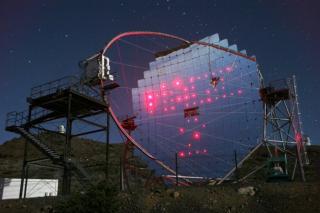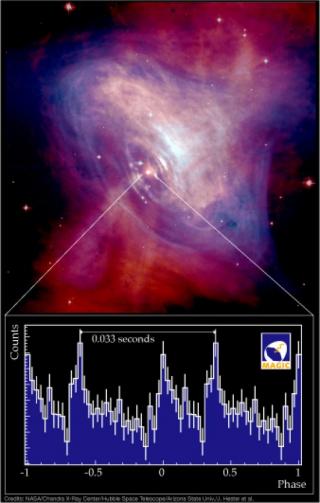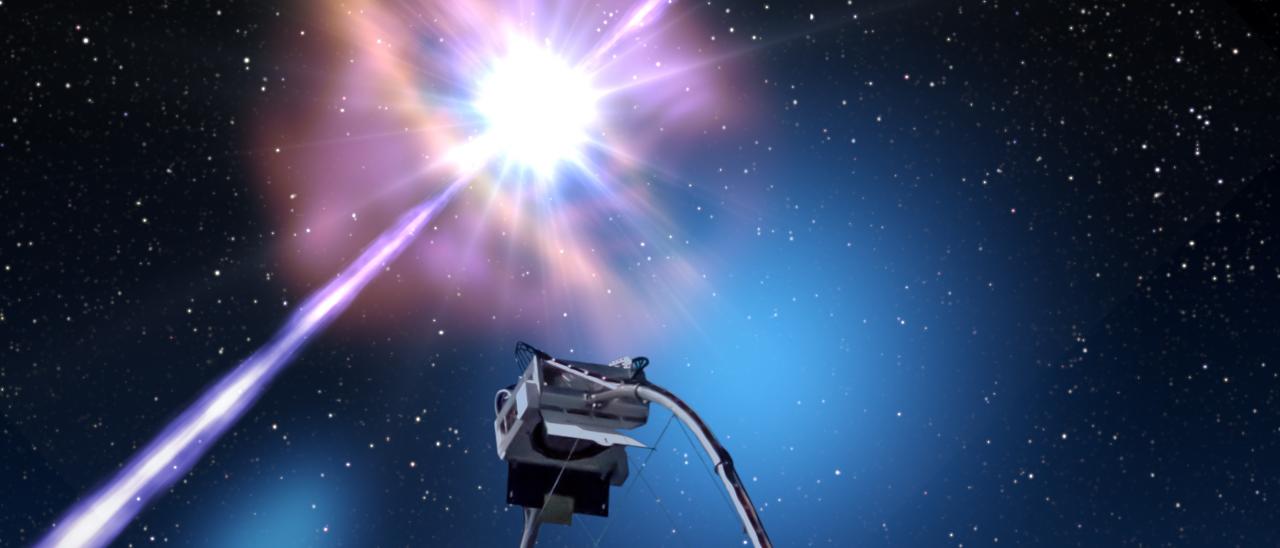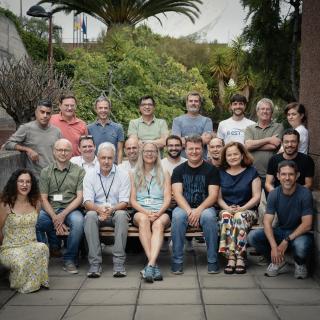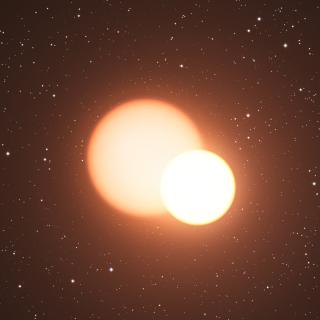This ground-breaking achievement by MAGIC provides critical new insight for understanding the physical processes at work in the most powerful cosmic explosions. The results are published in two articles in the Nature Journal.
Gamma-ray bursts (GRBs) are brief and extremely powerful cosmic explosions, suddenly appearing in the sky, about once per day. They are thought to result from the collapse of massive stars or the merging of neutron stars in distant galaxies. They commence with an initial, very bright flash, called the prompt emission, with a duration ranging from a fraction of a second to hundreds of seconds. The prompt emission is accompanied by the so-called afterglow, a less brighter but longer-lasting emission over a broad range of wavelengths that fades with time.
The first GRB detected by the MAGIC telescopes, known as GRB 190114C, reveals for the first time the highest energy photons measured from these objects. This ground-breaking achievement by MAGIC provides critical new insight for understanding the physical processes at work in GRBs, which are still mysterious. The photons detected by MAGIC must originate from a process hitherto unseen in the afterglows of GRBs, clearly distinct from the physical process that is known to be responsible for their emission at lower energies.
MAGIC detection and multi-wavelength observations of GRB 190114C
On January 14th, 2019, a GRB was discovered independently by two space satellites: the Neil Gehrels Swift Observatory and the Fermi Gamma-ray Space Telescope. The event was named GRB 190114C, and within 22 seconds, its coordinates in the sky were distributed as an electronic alert to astronomers worldwide, including the MAGIC Collaboration, which operates two 17m diameter Cherenkov telescopes located in the Observatorio del Roque de los Muchachos (Garafía, La Palma).
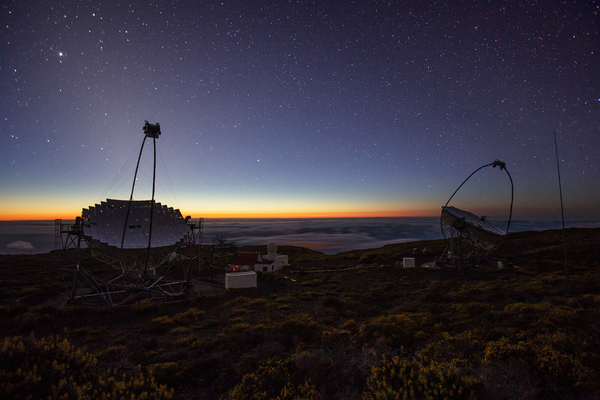
Since GRBs appear at unpredictable locations in the sky and then rapidly fade, their observation by telescopes such as MAGIC requires a dedicated follow-up strategy. An automatic system processes in real time the GRB alerts from satellite instruments and makes the MAGIC telescopes point rapidly to the sky position of the GRB. The telescopes were designed to be very light and capable of fast repointing: despite the weight of 64 tons each, they can reach and start observing any given position in the sky in just about 25 seconds. MAGIC was able to start the observation of GRB 190114C just 50 seconds after the beginning of the GRB. María Victoria Fonseca, president of the MAGIC Collaboration Board notes: "The telescopes were designed to be very light and be able to move quickly. Despite weighing 64 tons each, they can rotate 180 degrees in just 25 seconds. Thanks to this, MAGIC started observing GRB 190114C only 50 seconds after its start".
The analysis of the resulting data for the first tens of seconds reveals emission of photons in the afterglow reaching teraelectronvolt (TeV) energies, that is, a trillion times more energetic than visible light. During this time, the emission of TeV photons from GRB 190114C was 100 times more intense than the brightest known steady source at TeV energies, the Crab Nebula. In this way, GRB 190114C became the record setter as the brightest known source of TeV photons. As expected for GRB afterglows, the emission faded quickly with time, similar to the afterglow emission that had been known at lower energies. The last glimpses were seen by MAGIC half an hour later.
For the very first time, the unambiguous detection of TeV photons from a GRB was announced by the MAGIC Collaboration to the international community of astronomers just a few hours after the satellite alerts, after a careful check of the preliminary data. This facilitated an extensive campaign of multi-wavelength (MWL) follow-up observations of GRB 190114C by over two dozens of observatories and instruments, providing a full observational picture of this GRB from the radio band to TeV energies. In particular, optical observations allowed a measurement of the distance to GRB 190114C. It was found that this GRB is located in a galaxy from which it took 4.5 billion years for the light to reach the Earth.
Highest energy photons from a newly revealed emission process
Although TeV emission in GRB afterglows had been predicted in some theoretical studies, it had remained observationally elusive for a long time, despite numerous searches at TeV energies over the past decades with various instruments, including MAGIC. What physical mechanism is behind the production of the TeV photons finally detected by MAGIC? These energies are much higher than what can be expected from synchrotron radiation, caused by high-energy electrons spiraling in magnetic fields. This process is understood to be responsible for the emission that had been previously observed at lower energies in GRB afterglows.

"The night we detected the GRB 190114C, it was in the control room of the MAGIC telescopes. From the first moment, we realized that the photons we were seeing passed the synchrotron radiation limit. These new results, together with the very comprehensive MWL data, provide the first unequivocal evidence for an additional, distinct emission process in the afterglow", says Elena Moretti, astrophysics of the Spanish community and one of the main authors of the results. The most likely origin of the TeV emission is the so-called inverse Compton process, where a population of photons are significantly kicked up in energy by colliding with high energy electrons.
“After more than 50 years since GRBs were first discovered, many of their fundamental aspects still remain mysterious”, says Razmik Mirzoyan, the Spokesperson of the MAGIC Collaboration. “The discovery of gamma-ray emission from GRB 190114C in the new, TeV window of the electromagnetic spectrum shows that the GRB explosions are even more powerful than thought before. The wealth of new data on GRB 190114C acquired by MAGIC and the extensive MWL follow-up observations now offer important clues to unravel some of the mysteries concerning the physical processes at work in GRBs”.
A comparative study of all previous GRB follow-ups by MAGIC suggests that GRB 190114C was not a particularly unique event except for its relative proximity (light took 4.5 billion years to reach the Earth), and that the successful detection owes to the excellent performance of the instrument. MAGIC has opened a new window to study GRBs. The results indicate we may be able to detect many more GRBs at TeV energies. This will pave the way for a much deeper understanding of these fascinating cosmic explosions.
The Spanish community has participated in MAGIC since its inception. Currently, the following are members of MAGIC: Centro de Investigaciones Energéticas, Medioambientales y Tecnológicas (CIEMAT), Instituto de Astrofísica de Canarias (IAC), Institut de Física d'Altes Energies (IFAE), Universidad Autónoma de Barcelona (UAB), Instituto de Ciencias del Cosmos de la Universidad de Barcelona (UB) and Universidad Complutense de Madrid (UCM). In addition, MAGIC's data centre is the Port d'Informació Científica (PIC), a collaboration between IFAE and CIEMAT.
Articles:
"Teraelectronvolt emission from the γ-ray burst GRB 190114C"
"Observation of inverse Compton emission from a long γ-ray burst"
More information:
Max-Planck-Institute for Physics Press Release
Institut de Física d’Altes Energies Press Release
Contacts:
Razmik Mirzoyan, Spokesperson of the MAGIC Collaboration and Senior Astrophysicist at Max-Planck-Institute for Physics: razmik.mirzoyan [at] mpp.mpg.de (razmik[dot]mirzoyan[at]mpp[dot]mpg[dot]de)
Maria Victoria Fonseca, President of the MAGIC Collaboration Board and astrophysics of the Universidad Complutense de Madrid: fonseca [at] fis.ucm.es (fonseca[at]fis[dot]ucm[dot]es)
Elena Moretti, coordinator of transitory sources of the MAGIC Collaboration and astrophysics of the Institut de Física d’Altes Energies: moretti [at] ifae.es (moretti[at]ifae[dot]es)
Contacts at the IAC:
Alicia López Oramas, researcher of the MAGIC collaboration at the IAC: alicia.lopez [at] iac.es (alicia[dot]lopez[at]iac[dot]es)
Mónica Vázquez Acosta, representative of the Astroparticles research line at the IAC: monicava [at] iac.es (monicava[at]iac[dot]es)
Ramón García López, principal investigator of the group of Astroparticles at the IAC: rgl [at] iac.es (rgl[at]iac[dot]es)
